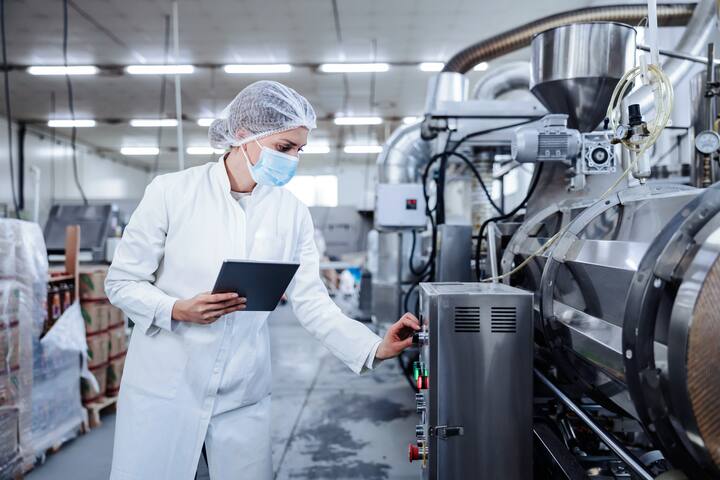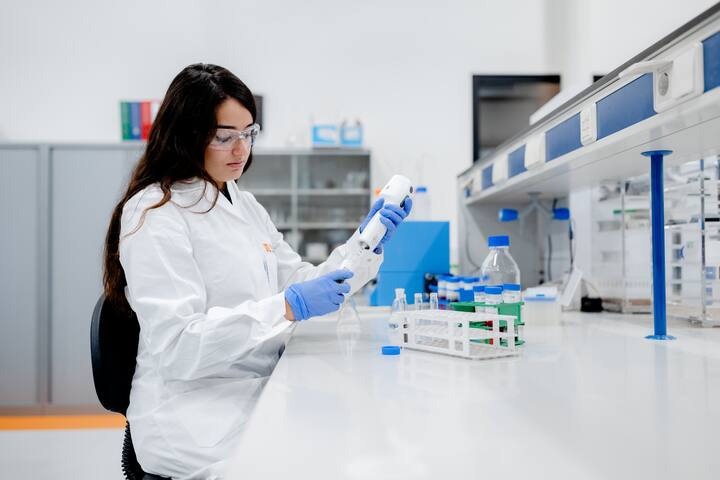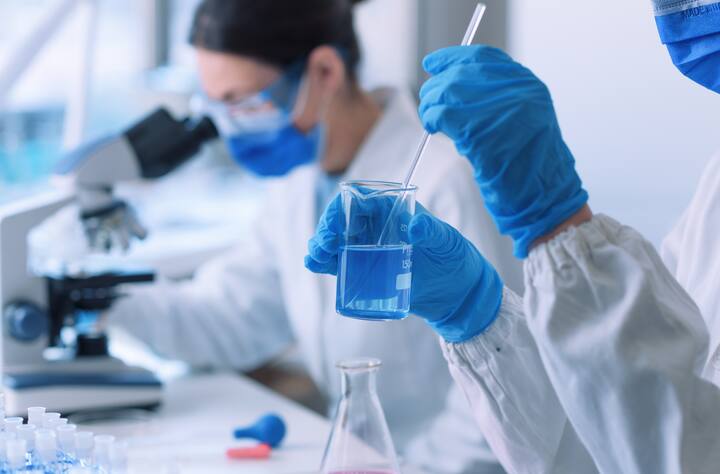
Environmental pathogens
This is a premium article. Premium articles are part of the Normec Foodcare Knowledge Centre subscription. All knowledge and experience from every area of expertise is brought together in the Knowledge Base. Here you will find all relevant information about various product groups and legislation. Curious? Read what the Normec Foodcare Knowledge Centre can offer you.
Pathogens are a common topic in the food industry because contamination of food with pathogens can be dangerous to consumer health. During the production process, pathogens can occur in the product but also in the environment of the production location. We refer to this as an environmental pathogen. Different environmental pathogens are present in different sectors of the food industry.
What is an environmental pathogen and how can it get into the product?
Environmental pathogens are disease-causing agents (such as bacteria, viruses, fungi or parasites) that can occur in the environment — outside the body of humans or animals — and cause infection from there. They can be found in water, soil, surfaces in the production environment, air and other places within the production environment. These pathogens can survive and even grow in the production environment for long periods of time. Environmental pathogens therefore pose a major risk to consumers because they can contaminate products after a reduction treatment has taken place. We refer to this as cross-contamination. It is therefore important to identify these pathogens and draw up a good monitoring plan to prevent the growth of environmental pathogens.
The most common environmental pathogens in the food industry are Listeria monocytogenes and Salmonella spp. Legislation also focuses most on these two pathogens. In addition, there are various other environmental pathogens that are particularly relevant in specific sectors. Examples include
Bacillus cereus
E. coli (STEC)
Campylobacter spp.
Enterobacteriaceae
Staphylococcus aureus
Clostridium perfringens
Passers-by and persistent strains
It is important to note that transient or persistent strains (house strains) may be present in the production environment. Passing strains are found once during environmental monitoring and can be removed by cleaning and disinfection procedures, while persistent strains can be found again over a longer period of time. They can, for example, establish themselves in niches and become a recurring problem because they may not be completely inactivated by standard cleaning and disinfection procedures.
The growth of pathogens depends heavily on the conditions in which the pathogen is found. Factors such as temperature, the presence of nutrients, pH, aw value (water activity), salt content and oxygen presence can cause a pathogen to grow rapidly or, conversely, to decline. It is therefore important to know what these parameters are within your company in order to better understand which pathogens may pose a risk. Below, we will describe which environmental pathogens may pose a danger and for which sectors specifically.

Listeria Monocytogenes
Listeria monocytogenes is a bacterium belonging to the Listeriaceae family and is known as a dangerous environmental pathogen, especially in the food industry. The bacterium can cause the disease listeriosis, a serious infection that mainly affects high-risk groups such as pregnant women, the elderly and people with weakened immune systems. Listeria can also form so-called biofilms in which the bacterium is more robust and can attach itself to surfaces.
Listeria monocytogenes is unique in its ability to grow under conditions where many other bacteria cannot:
Temperature range: grows between -0.4°C and 45°C, with an optimum between 30–37°C. This means that the bacterium can grow in refrigerated products.
pH range: has a pH tolerance between 3.3-9.6, with an optimum of 7. No growth is possible below a pH of 4.4.
Aw value: grows above an Aw value of 0.92, with an optimum of 0.97. Does not grow below an Aw value of 0.92.
Salt tolerance à Can grow at salt levels up to 10%. Survives in salt levels of 20%.
Oxygen presence à Listeria is facultative anaerobic, which means that it can grow with or without oxygen.
Because we consider it an environmental pathogen, it may be present on the product, but it also has other possible habitats:
Damp and cool production environments
Drains, floor drains, seams and cracks in machines
Places where condensation can form
Biofilms (Listeria can attach itself to biofilms, making it more resistant to standard cleaning and disinfection)
The bacterium also occurs naturally in the environment, such as in soil, water, plants and animal faeces. Listeria is not demanding in terms of nutrients. It grows well in protein-rich and carbohydrate-rich environments such as:
Meat products (cooked/boiled)
Soft cheeses and dairy products (brie, camembert, raw milk cheeses)
Fish (smoked)
Ready-to-eat products
Pre-packaged raw vegetables and/or salads
Listeria monitoring is particularly important in sectors where refrigerated, ready-to-eat products are produced. The reason for this is that these products have often already undergone a reduction treatment, which means that post-contamination can cause consumers to consume the pathogen directly without a heating step.
Therefore, relevant sectors for Listeria monocytogenes are:
Meat and poultry processing companies (in particular cooked and cooked products such as meat products)
Dairy industry (especially soft cheeses and raw milk products)
Fish processing companies (especially smoked,
raw
salmon or other fish species)
Vegetable processing companies (especially raw vegetable salads and cut vegetables)
Ready-to-eat products (ready meals)
In addition to the increased risk in these sectors, Listeria monocytogenes is a relevant hazard for virtually every sector. Ensure that the factors that can promote or inhibit the growth of listeria are identified so that a good assessment can be made of the risk of listeria contamination.
Salmonella spp.
Salmonella spp. are a group of bacteria within the Enterobacteriaceae family that are known worldwide as a cause of food infections. Salmonella is common in farm animals and their products and is therefore a frequent cause of gastrointestinal infections. It causes the disease salmonellosis.
Salmonella has relatively mild requirements for growth and survival:
Temperature range: grows between 8°C and 47°C, with an optimum around 37°C.
pH range: tolerance of approximately pH 4.4 to 9, with optimal growth between pH 6.5–7.5.
Aw value: grows from a minimum aw of 0.95, but can survive at lower values.
Oxygen requirement: facultative anaerobic — grows both with and without oxygen.
Dry conditions: Salmonella can survive in dry conditions.
Salmonella occurs naturally in the intestines of animals and can enter the environment via faeces. At production sites, it can enter via contaminated raw materials such as raw meat, eggs, herbs or nuts. The bacteria can survive on dry surfaces, in dust and in hard-to-clean areas such as seams, cracks and machines. Salmonella can also accumulate in damp areas such as drains, wet floors and condensation points. It can spread via personnel, air currents or cross-contamination between “dirty” and “clean” areas.
Salmonella is a bacterium that has relatively few dietary requirements and uses a wide range of nutrients that are often found in animal products. These include mainly proteins and fats, but sugars and minerals are also used as nutrients for Salmonella spp. In terms of products, this includes:
Meat, eggs and dairy products (proteins)
Dough, dairy and vegetables (carbohydrates)
Meat preparations and sauces (fats)
This preference for nutrients is also reflected in the sectors where salmonella is particularly prevalent. These include:
Meat and poultry industry
Egg processing
Dairy industry
Animal feed sector
Salmonella can also occur in other product groups because it can survive in dry conditions and therefore still end up in a product. It is crucial to be aware of this because dry products are often not immediately considered to be at risk for salmonella. Examples include:
Herbs and spices
Nuts and peanuts
Chocolate
Flour
Bacillus Cereus
Bacillus cereus is a spore-forming bacterium that is commonly found in nature and in food production environments. The bacterium is particularly notorious for its ability to produce heat-stable toxins that can cause food poisoning. These spores are difficult to remove, which means that they can remain in the product even after reduction steps such as pasteurisation and cooking.
The growth factors of Bacillus cereus:
Temperature range: grows between 5°C and 50°C, with an optimum around 30–37°C.
Some strains can even grow at refrigeration temperatures, making them dangerous in refrigerated products.
pH range: approximately 4.3 to 9.3, with an optimum around 6–7.
Aw value: grows from a minimum aw of 0.91, but survival in dry products via spores is excellent.
Salt content: grows up to a salt content of 10%
Oxygen content: B. cereus is facultative anaerobic – it grows both with and without oxygen.
As mentioned earlier, B. cereus forms spores that are highly resistant to heat, dehydration and chemical cleaning – these can survive pasteurisation and drying.
Bacillus cereus occurs naturally in soil, dust, plant material and water, and is therefore widespread in the environment. The bacterium can enter production sites via raw materials such as grains, rice, milk and vegetables.
Because B. cereus forms spores, it can survive on surfaces, in dust particles and in dry products such as powders or herbs. Poor hygiene, inadequate cleaning of equipment or the use of contaminated raw materials increase the risk of spread. B. cereus obtains its nutrients from proteins and sugars, but mainly from starch. The bacterium can efficiently convert starch into nutrients and then produce toxins. This is why B. cereus can occur frequently in products such as:
Potatoes, rice, pasta and grains
Milk and cream products (both raw and powdered)
Desserts/pastries
Herbs and spices
Prepared meals and meal salads with herbs and starch components
This means that there are a number of sectors that are more likely to encounter B. cereus during their production process:
Dairy industry (milk and desserts)
Grain processing industry (source of starch)
Herbs and spices industry
Prepared meals
In addition to various sectors in the production process, there is also a high risk of encountering B. cereus in commercial kitchens or catering companies. These include restaurants, canteens and other businesses where food is prepared. Because products are stored (not always properly refrigerated), pre-cooked and reheated, there is a risk of toxin formation.
E. Coli (STEC)
Escherichia coli (STEC), also known as Shiga toxin-producing Escherichia coli, is a bacterium that lives in the intestinal tract of humans and animals, but can also survive in the environment. It is best known for causing severe food poisoning, with symptoms ranging from diarrhoea to kidney failure (HUS – haemolytic-uraemic syndrome). The danger lies mainly in the production of Shiga toxins, which are harmful to the intestines and kidneys.
The growth conditions for STEC are as follows:
Temperature range: grows between 2.5 °C and 50 °C, with an optimum of 37 °C
pH range: grows between a pH of 4.2 and 9.5, with an optimum of 6.8
Aw value: grows from a minimum Aw value of 0.935.
Oxygen content: STEC is facultative anaerobic – it grows both with and without oxygen present.
Shiga toxin-producing Escherichia coli (STEC) lives naturally in the intestines of animals, especially cattle, where it enters the environment via faeces. It enters production sites via raw meat, vegetables (via contaminated water or manure) and inadequately processed dairy products. The bacteria can survive on the surfaces of machines, floors and packaging materials, especially if these are not cleaned properly.
STEC can survive in both cold and warm environments, which increases the risk. Poor hygiene practices, such as cross-contamination between raw and prepared food, allow STEC to continue to spread within the production site.
The main food sources of STEC are products that are rich in protein, fat and sugar. Examples include:
Raw meat (mainly beef)
Dairy products (mainly raw milk products)
Vegetables (also mainly raw products)
Fruit juices (unpasteurised)
Therefore, relevant sectors in which STEC is more likely to occur are also sectors in which these products are produced. These include:
Meat processors that produce raw beef products
Dairy processors that produce raw milk products
Vegetable processors that produce unprocessed products where the vegetables may be contaminated with polluted water, for example.
Fruit juice producers where the product is not pasteurised.
Campylobacter spp.
Campylobacter spp. (especially Campylobacter jejuni and Campylobacter coli) are bacteria that are responsible for one of the most common food infections in humans worldwide: campylobacteriosis. Even a small amount of bacteria is enough to make someone ill. These bacteria can cause severe gastrointestinal symptoms, such as diarrhoea, abdominal pain, fever and, in some cases, serious complications such as Guillain-Barré syndrome.
The growth conditions for campylobacter are as follows:
Temperature range: grows between 32°C and 45°C, with an optimum around 41–42°C. Campylobacter is a thermophilic bacterium and grows best at around the body temperature of poultry. The bacterium cannot grow outside the body of animals.
pH range: approximately 4.9 to 9.0
Aw value: Grows from a minimum Aw of 0.99 and is sensitive to dehydration.
Salt content: grows from a salt content of 2-4.5%
Oxygen content: Campylobacter is microaerophilic, which means that it grows at low oxygen levels. The optimum is between 6-10% O2 with 2-10% CO2.
Campylobacter is found in the gastrointestinal tract of warm-blooded animals, mainly poultry, but other animals can also be carriers. At production sites, the bacterium is often found in poultry slaughterhouses on cutting machines, floor surfaces, workbenches and pipes. The bacterium can also spread easily through cross-contamination, both at the production site and ultimately in the consumer's kitchen.
Compared to other environmental pathogens, Campylobacter has a more specific preference for nutrients. It prefers amino acids as an energy source, specifically the amino acids asparagine, serine and glutamine. Unlike other pathogens, Campylobacter does not use sugars as a food source, which means it grows well on protein-rich products such as meat and milk.
Campylobacter is an environmental pathogen that can occur in animal products. The most relevant sectors that need to take this environmental pathogen into account are therefore as follows:
Poultry processing
This is by far the most important sector. Poultry is the natural carrier of Campylobacter and the pathogen grows best in these conditions.
Meat processing of other animal species
Milk and dairy processors
Staphylococcus Aureus
Staphylococcus aureus (S. aureus) is a common bacterium that lives on the skin and mucous membranes of humans and animals. This bacterium can cause food infections through toxin formation and is considered a typical environmental pathogen due to its ability to survive for long periods on surfaces and spread via personnel or air particles.
The growth conditions of S. aureus are as follows:
Temperature range: grows between 7°C and 48°C, with an optimum around 35°C. Toxins can be produced between 10°C and 48°C.
pH range: approximately 4.5 to 9.3, with optimum growth at 6.8
Aw value: grows from a minimum Aw of 0.83-0.86 and therefore thrives in dry environments.
Salinity: S. aureus is halotolerant, allowing it to grow in environments with a salinity of up to 15%.
Oxygen content: S. aureus is a facultative anaerobic bacterium – it grows both with and without oxygen.
S. aureus is an environmental pathogen that is not commonly found in products themselves but occurs naturally on the skin, nose and throat of humans and animals.
Within production locations, it can occur via personnel themselves (especially with poor hygiene), contact surfaces such as cutting boards and workbenches, and can adhere to rough surfaces through the formation of biofilm. The nutrients that S. aureus uses to grow are mainly found in protein- and carbohydrate-rich products such as:
Meat products
Dairy products
Egg products
Pastries
Fish products
S. aureus is particularly contagious through poor preparation techniques in kitchens and commercial kitchens, with cross-contamination being the greatest risk. S. aureus also becomes a problem when products are not stored at the correct temperature. In such cases, the following sectors are particularly susceptible to S. aureus:
Dairy industry
Meat and meat products industry
Pastry and bakery sector
Hospitality, catering and commercial kitchens
Fish processing industry



